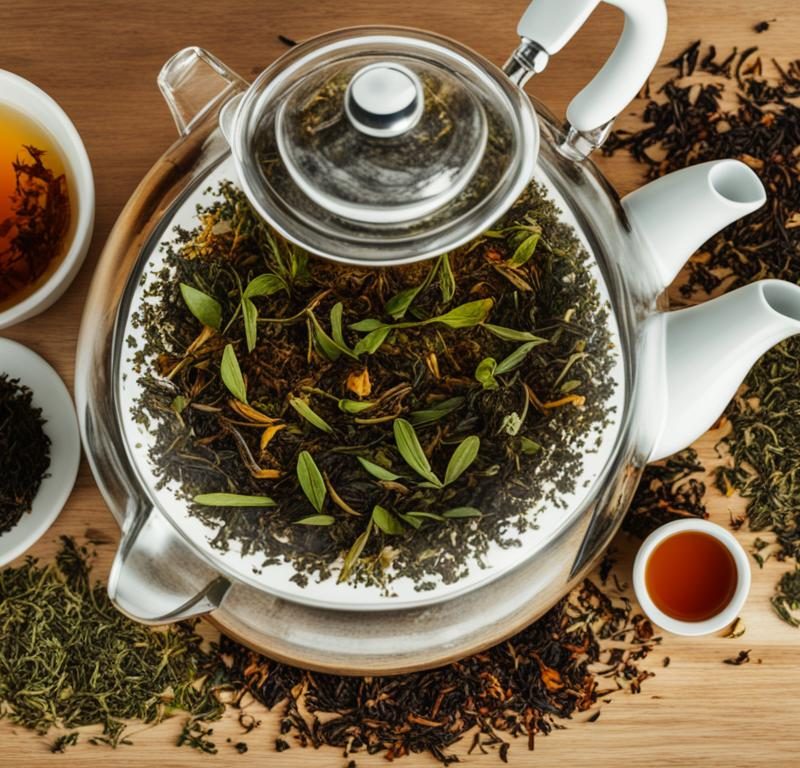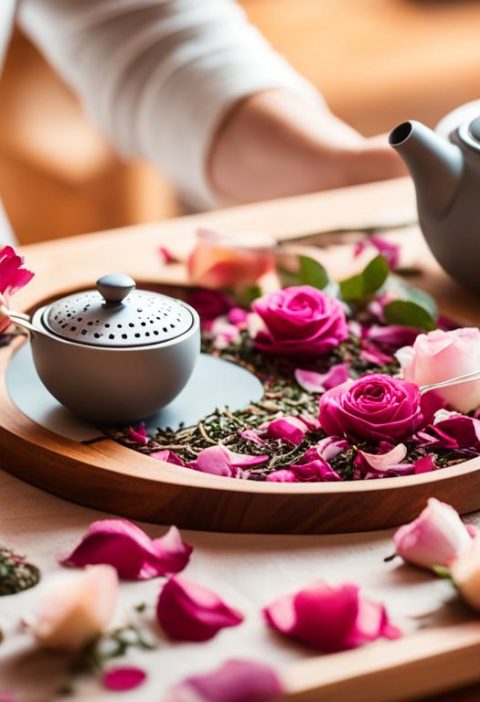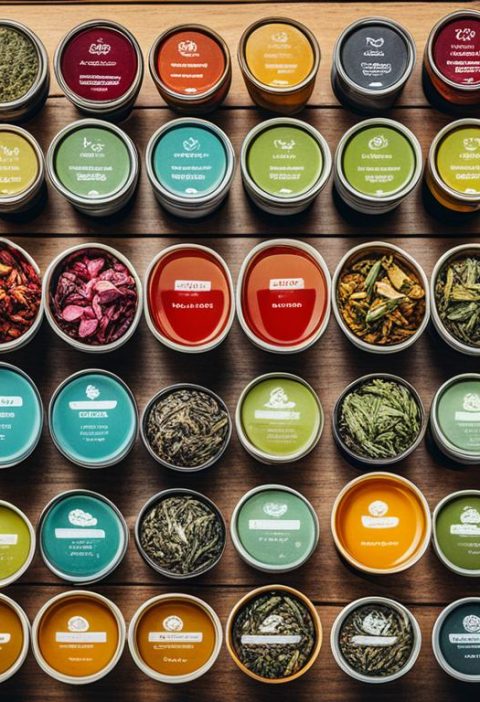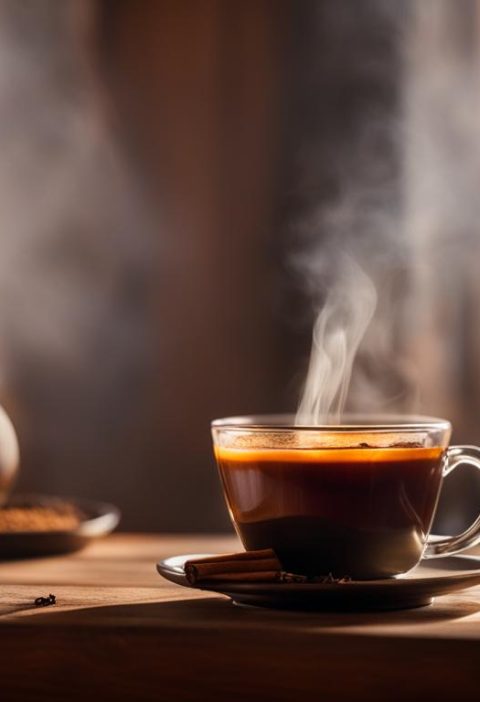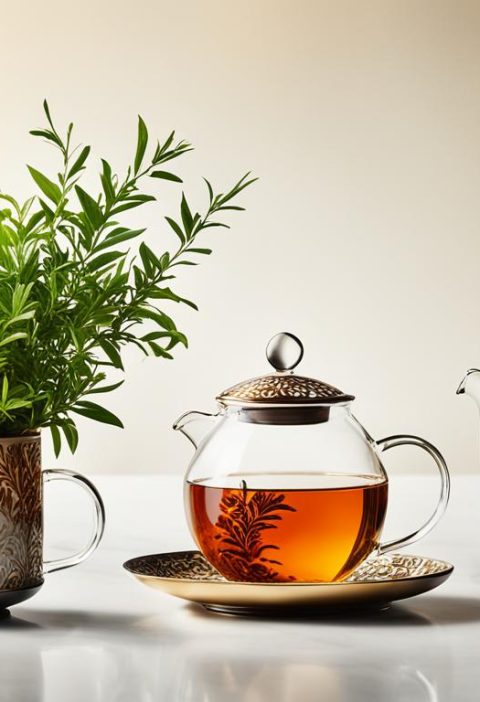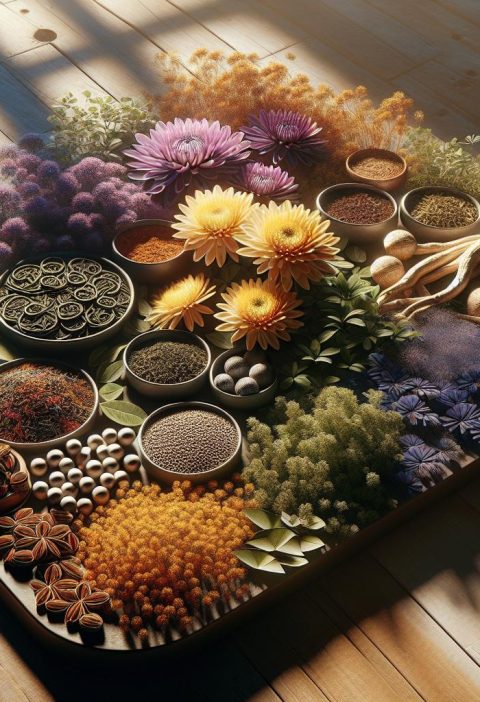Brewing the perfect cup of tea requires attention to detail and an understanding of tea brewing techniques. In this guide, we will explore the art of steeping blended teas and provide tips for enhancing the flavors of your tea.
Start with High-Quality Tea Leaves
The foundation of a great cup of tea lies in the quality of the tea leaves. Opt for loose-leaf tea over tea bags whenever possible, as loose-leaf tea offers better flavor and aroma. It contains whole leaves and larger pieces, allowing for better infusion and a more enjoyable tea-drinking experience.
Measure Your Tea Leaves
The right tea-to-water ratio is crucial for a balanced flavor. Use about one teaspoon of loose tea leaves per 8 ounces of water as a general guideline. However, different teas may require slight adjustments, so consult the packaging or recommendations from experts for precise measurements. Larger cups may require more tea leaves, and you can adjust steeping times accordingly.
Use Fresh, Filtered Water
The quality of water used can significantly impact the taste of tea. Use fresh, cold, and filtered water whenever possible to ensure the best flavor in your steeped tea. Avoid using stale or reused water, as it can affect the overall taste and enjoyment of your tea.
Pay Attention to Water Temperature
Different types of tea require specific water temperatures to extract their best flavors. Black tea typically requires boiling water, while green and white teas need slightly lower temperatures. Using a thermometer or an electric kettle with temperature settings can help you achieve the ideal water temperature for your chosen tea.
Mind the Steeping Time
The steeping time determines the strength and flavor of your tea. Each type of tea has its own recommended steeping time, with black, green, white, oolong, and herbal teas having different guidelines. Oversteeping can lead to bitterness, while under-steeping may result in a weak brew. Set a timer to ensure you achieve the desired flavor profile.
Use the Right Teapot or Infuser
Investing in a good-quality teapot or infuser is important for a flavorful cup of tea. Opt for a teapot or infuser that allows the tea leaves to expand fully and infuse their flavors properly. A tea steeping basket is a smart choice, as it provides ample space for the leaves to unfurl and ensures a more flavorful brew.
Pour and Sip Mindfully
Once your tea has steeped to perfection, pour it into your favorite cup or mug. Take a moment to inhale the aroma before taking a sip. Sip slowly, savoring the flavors and enjoying the warmth of the tea. Mindful tea-drinking enhances the overall tea experience and allows you to fully appreciate the flavors and aromas of your blended tea.
Brewing Tea: A Delightful Journey of Flavors and Aromas
Brewing the perfect cup of tea is a delightful journey of flavors and aromas. By following the tea brewing techniques and tips provided in this guide, you can enhance your tea-drinking experience and enjoy a consistently excellent cup of tea every time. Whether you prefer a robust black tea or a delicate green tea, the key lies in your patience and dedication to the craft of tea brewing.
Experimentation and Personal Tea Odyssey
As you become more experienced in tea brewing, don’t be afraid to experiment with different tea-to-water ratios, steeping vessels, and steeping times. Each cup of tea is an opportunity to discover new flavors and create a personalized tea experience. Embrace the journey of tea brewing and revel in the joys of discovering unique tea profiles that resonate with your taste buds.
Key Takeaways:
- Start with high-quality loose-leaf tea for better flavor and aroma.
- Measure your tea leaves according to the recommended tea-to-water ratio.
- Use fresh, filtered water to enhance the taste of your tea.
- Pay attention to water temperature and steeping time for different types of tea.
- Invest in a good-quality teapot or infuser that allows for proper flavor extraction.
Start with High-Quality Tea Leaves
The foundation of a great cup of tea lies in the quality of the tea leaves. Opt for loose-leaf tea over tea bags whenever possible, as loose-leaf tea offers better flavor and aroma. It contains whole leaves and larger pieces, allowing for better infusion and a more enjoyable tea-drinking experience.
When you choose high-quality loose-leaf tea, you can visually admire the vibrant colors and unique shapes of the leaves. These qualities indicate the freshness and purity of the tea, ensuring a delightful brewing process and a delightful tea-drinking experience.
Benefits of Loose-Leaf Tea
Loose-leaf tea is a popular choice among tea enthusiasts for several reasons:
- Whole leaves and larger pieces allow for better infusion
- Greater flavor and aroma compared to tea bags
- More control over the tea-to-water ratio
- Greater variety and selection of tea blends
By choosing loose-leaf tea, you have the opportunity to explore a wide range of flavors, from delicate and floral to bold and robust. The process of brewing loose-leaf tea becomes a ritual that engages your senses and enhances your enjoyment of this ancient beverage.
Choosing the Right Loose-Leaf Tea
When selecting loose-leaf tea, consider your personal preferences and taste preferences. Experiment with different tea types, such as black, green, white, oolong, and herbal teas, to discover the flavors that suit your palate.
In addition to the type of tea, pay attention to the origin and quality of the tea leaves. Look for teas sourced from reputable tea estates that prioritize sustainability and ethical practices. This ensures that you are not only getting high-quality tea but also supporting environmentally conscious tea cultivation.
Exploring Loose-Leaf Tea Blends
Loose-leaf tea blends provide an opportunity to experience a harmonious combination of flavors. Blends often incorporate herbs, fruits, spices, or flowers to create unique taste profiles that tantalize your taste buds.
When exploring loose-leaf tea blends, consider the time of day, your mood, and the desired flavor experience. Whether you’re craving a soothing herbal infusion before bed or a vibrant floral blend to start your morning, there’s a loose-leaf tea blend to suit every occasion.
| Tea Type | Flavor Profile | Suggested Blends |
|---|---|---|
| Black Tea | Rich, Bold, Malty | Assam Breakfast, Earl Grey, Masala Chai |
| Green Tea | Grassy, Fresh, Vegetal | Matcha, Sencha, Jasmine Green |
| White Tea | Delicate, Floral, Subtle | Silver Needle, White Peony, Peach Blossom |
| Oolong Tea | Complex, Aromatic, Creamy | Tie Guan Yin, Oriental Beauty, Da Hong Pao |
| Herbal Tea | Fruity, Spicy, Relaxing | Chamomile, Peppermint, Rooibos |
Measure Your Tea Leaves
When it comes to steeping blended teas, the proper tea-to-water ratio is essential for achieving a balanced and flavorful cup. Follow our guidelines to ensure precise measurements and a delightful tea experience.
Tea-to-Water Ratio
The general rule of thumb is to use approximately one teaspoon of loose tea leaves per 8 ounces of water. This ratio provides a good starting point for most teas. However, different teas may require slight adjustments to achieve the desired flavor profile.
Precise Measurements
For precise measurements, consult the packaging of your tea or seek recommendations from tea experts. They often provide specific instructions on the ideal amount of tea to use based on the type and quality of the tea leaves. Following these recommendations ensures consistent and accurate results.
Adjustments and Packaging
It’s important to note that the recommended tea-to-water ratio may vary depending on personal preference, cup size, and the strength of flavor desired. Larger cups may require more tea leaves to maintain the optimal flavor intensity. You may also need to adjust the steeping time accordingly.
Additionally, tea packaging often provides helpful instructions for measuring tea leaves. Some tea brands even include measuring spoons with their products for convenience and accuracy.
Tea-to-Water Ratio Guide
| Type of Tea | Tea-to-Water Ratio |
|---|---|
| Black Tea | 1 teaspoon per 8 ounces of water |
| Green Tea | 1 teaspoon per 8 ounces of water |
| Oolong Tea | 1 teaspoon per 8 ounces of water |
| White Tea | 1 teaspoon per 8 ounces of water |
| Herbal Tea | 1 teaspoon per 8 ounces of water |
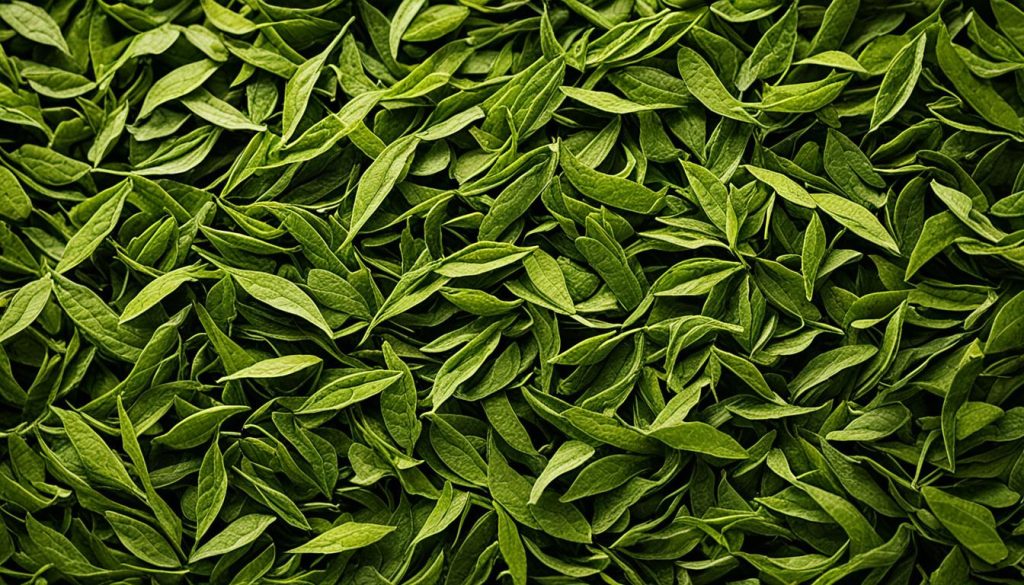
Remember, the tea-to-water ratio is just one piece of the puzzle when it comes to brewing the perfect cup. Stay tuned as we continue to explore more tea brewing techniques and tips in our Mastering the Steeping of Blended Teas Guide.
Use Fresh, Filtered Water
The quality of water used can significantly impact the taste of tea. It is essential to use fresh, cold, and filtered water when brewing your favorite cup of tea. Fresh water ensures that there are no impurities or off-flavors that can detract from the tea’s taste and aroma. Filtered water helps remove any additional contaminants, resulting in a clean and pure brew.
Using stale or reused water can have a negative impact on the overall taste and enjoyment of your tea. Stale water may contain residual flavors or odors that can alter the tea’s true character. Reused water may have a higher mineral content, which can affect the extraction of flavors from the tea leaves.
By prioritizing water quality and opting for fresh and filtered water, you can ensure that your tea tastes its absolute best. The pure and clean properties of quality water create the perfect canvas for the delicate flavors and aromas of your favorite teas to shine.
For tea enthusiasts, investing in a water filtration system can greatly enhance your brewing experience. Consider a system that removes impurities and adds minerals to achieve the ideal water composition for brewing tea.
| Type of Water | Impact on Tea Taste |
|---|---|
| Fresh, Filtered Water | Enhances the true flavors and aromas of tea. |
| Stale Water | May introduce undesirable flavors or odors to the tea. |
| Reused Water | Higher mineral content can affect tea extraction and taste. |
Pay Attention to Water Temperature
Different types of tea require specific water temperatures to extract their best flavors. Achieving the ideal water temperature for your chosen tea is crucial to enhancing its taste and aroma. Here are some general guidelines for water temperature based on different tea types:
| Tea Type | Ideal Water Temperature |
|---|---|
| Black Tea | Boiling water (100°C/212°F) |
| Green Tea | Lower temperatures between 70-85°C (158-185°F) |
| White Tea | Lower temperatures between 70-85°C (158-185°F) |
Using the correct water temperature will ensure that the tea leaves are steeped to perfection, resulting in a well-balanced and flavorful cup of tea. To accurately measure water temperature, you can utilize a reliable thermometer or an electric kettle with temperature settings.
By paying attention to water temperature, you can bring out the unique characteristics and nuances of each tea type, delighting your taste buds with an extraordinary tea-drinking experience.
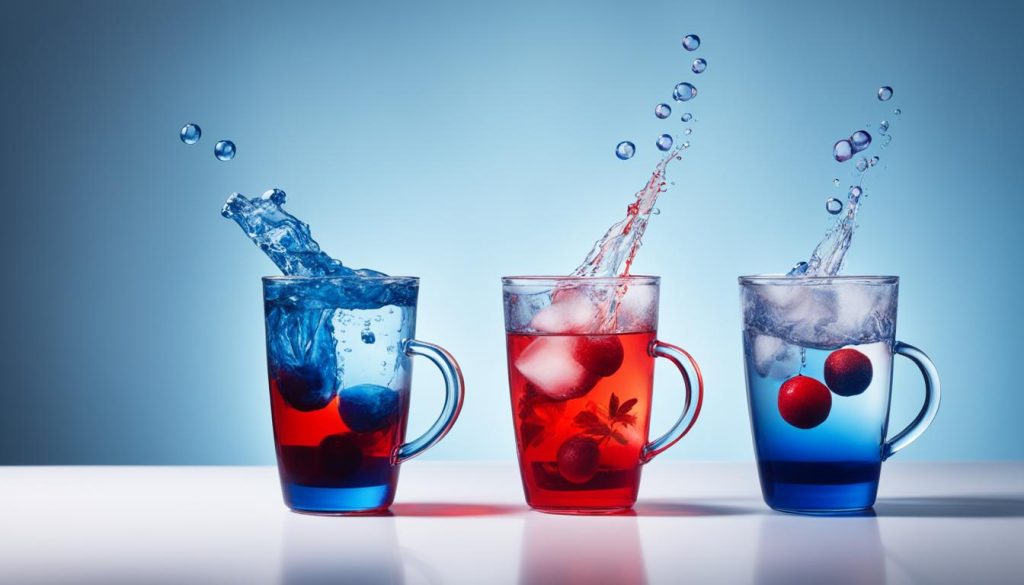
Mind the Steeping Time
The steeping time is a critical factor in determining the strength and flavor of your tea. Different types of tea require specific steeping times to achieve optimal results. Let’s take a look at the recommended steeping times for various tea varieties:
| Tea Type | Steeping Time |
|---|---|
| Black Tea | 3-5 minutes |
| Green Tea | 2-3 minutes |
| White Tea | 1-3 minutes |
| Oolong Tea | 3-5 minutes |
| Herbal Tea | 5-7 minutes |
It’s important to follow these guidelines to achieve the desired flavor profile and avoid any unpleasant taste characteristics. Oversteeping can lead to bitterness, while under steeping may result in a weak and lackluster brew. To ensure consistency, we recommend setting a timer or using a tea timer for accurate steeping.
Remember, every tea variety has unique characteristics, so it’s essential to adjust the steeping time according to your personal preferences. You have the flexibility to experiment with steeping times and fine-tune them to suit your desired tea strength and taste.
Use the Right Teapot or Infuser
Investing in a good-quality teapot or infuser is crucial for maximizing the flavor of your tea. The right tea brewing tools allow the tea leaves to expand fully, releasing their full potential and enhancing the overall tea experience. When choosing a teapot or infuser, consider the following:
- Teapot: A teapot is a classic and elegant option for steeping tea. Look for a teapot made from high-quality materials such as ceramic or glass, as they do not interfere with the tea’s flavor. Additionally, ensure that the teapot has a removable infuser, allowing for easy removal of the tea leaves once steeped.
- Infuser: An infuser is a convenient and portable option for steeping loose-leaf tea. Choose an infuser with fine, stainless steel mesh to prevent tea leaves from escaping into your cup. Consider an infuser with a handle or grip for easy removal from the cup.
- Tea Steeping Basket: A tea steeping basket provides ample space for tea leaves to unfurl and expand, allowing for optimal flavor extraction. This type of infuser is especially ideal for teas that require more room, such as blooming tea or herbal blends.
The Benefits of Using the Right Teapot or Infuser
Using the right teapot or infuser has several advantages:
- Maximizes Tea Flavor: A well-designed teapot or infuser allows tea leaves to expand fully, releasing their flavor into the brew. This results in a more robust and flavorful cup of tea.
- Prevents Oversteeping: An infuser with a removable filter or a tea steeping basket helps prevent oversteeping by providing an easy way to separate the leaves from the water once the desired steeping time is reached.
- Easy Cleanup: Teapots and infusers with removable parts make cleaning a breeze. Simply remove the infuser or filter, discard the tea leaves, and rinse with water.
Enhance your tea brewing experience by investing in a teapot or infuser that suits your preferences and allows for the optimal expansion of tea leaves. Experiment with different tea brewing tools to find the one that complements your tea-drinking routine and maximizes the flavors of your favorite teas.
Pour and Sip Mindfully
Once your tea has steeped to perfection, it’s time to pour and sip mindfully. This step is crucial in fully experiencing the flavors and aromas of your blended tea. Follow these steps to make the most out of your tea-drinking ritual:
1. Select your favorite cup or mug: Choose a vessel that brings you joy and enhances the tea-drinking experience. Whether it’s a delicate china tea cup or a cozy mug, find the right one for you.
2. Inhale the delightful aroma: As you pour the tea into your cup, take a moment to inhale the enchanting aroma rising from the liquid. Close your eyes and let the soothing scent of tea envelop your senses.
3. Sip slowly, savoring the flavors: Take a small, gentle sip and allow the flavors to dance across your palate. Notice the nuances and complexities in the taste profile. Pay attention to the balance of sweetness, bitterness, and any other notes that make the tea unique.
4. Engage your senses: Engage all your senses as you sip your tea. Feel the warmth of the cup in your hands, listen to the subtle sound of the liquid pouring and the gentle clinking of the spoon, and appreciate the visual beauty of the tea in your cup.
5. Practice mindfulness: Be fully present in the moment, focusing solely on the act of drinking tea. Let go of any distractions and immerse yourself in the simple pleasure of each sip. Pay attention to how the tea makes you feel, both physically and emotionally.
6. Create a peaceful tea-drinking environment: Find a quiet, serene space where you can fully enjoy your tea without interruptions. Create a cozy corner or set up a tranquil tea ceremony to enhance the overall experience.
By pouring and sipping mindfully, you can elevate your tea-drinking experience and fully appreciate the rich flavors and captivating aromas of your blended tea.
Brewing Tea: A Delightful Journey of Flavors and Aromas
Brewing the perfect cup of tea is a delightful journey of flavors and aromas. It is a process that allows us to unlock the true essence of tea and create a sensory experience that caters to our unique preferences. By following the tea brewing techniques and tips provided in this guide, you can enhance your tea-drinking experience and enjoy a consistently excellent cup of tea every time.
As we embark on this tea journey, we discover that each type of tea offers a distinct flavor profile and range of aromas. From robust black teas to delicate green teas, the world of tea is filled with a myriad of options to cater to our diverse tastes. We can explore various tea flavors, such as floral, fruity, earthy, or even spicy notes, depending on the type of tea leaves and the brewing method we choose.
When brewing tea, it is essential to consider our individual tea preferences. Some of us prefer a strong, bold cup of tea, while others enjoy a more delicate and subtle infusion. Our personal taste preferences can influence the steeping time, tea-to-water ratio, and even the water temperature we select. By experimenting and adjusting these variables, we can tailor our tea brewing process to suit our unique flavor preferences.
Tea aromas also play a significant role in our tea-drinking experience. The scent of various teas can be captivating, ranging from the floral fragrance of jasmine green tea to the rich, malty aroma of an Assam black tea. As we take that first sip, the aroma wafts up, enveloping our senses and enhancing the overall enjoyment of the tea.
To fully appreciate the flavors and aromas of brewed tea, we must savor each sip mindfully. Allow the tea to linger on the palate, experiencing the subtle nuances and complexities of the flavors. Take note of the tea’s texture, body, and aftertaste, as these elements contribute to the overall tea-drinking experience.
Remember, brewing tea is not just a process; it is an art. It requires patience, dedication, and a genuine passion for the craft. With each cup of tea we brew, we embark on a journey of discovery, exploring the endless possibilities and flavors that the world of tea has to offer.
The Art of Savoring Tea
Savoring tea is not just about taste; it is an experience that engages all of our senses. Here are some tips to enhance your tea savoring journey:
- Breathe in the aroma of the brewed tea before taking your first sip. Let the scents transport you to a world of flavors.
- Sip slowly, allowing the tea to coat your tongue and appreciate the various flavor notes that unfold.
- Pay attention to the tea’s texture and body, noticing the smoothness or thickness of the brew.
- Observe the color of the tea as you hold it up to the light, noting its vibrancy and clarity.
- Experience the lingering aftertaste, as it reveals the tea’s character and leaves a lasting impression.
Aromas and Flavors of Popular Tea Types
Each type of tea offers a unique combination of flavors and aromas. Here are some popular tea types and their characteristic profiles:
| Tea Type | Aromas | Flavors |
|---|---|---|
| Green Tea | Grassy, Vegetal, Floral | Light, Refreshing, Umami |
| Black Tea | Malty, Fruity, Earthy | Robust, Bold, Sweet |
| Oolong Tea | Floral, Fruity, Toasty | Complex, Balanced, Subtle |
| Herbal Tea | Herbaceous, Fruity, Spicy | Vibrant, Caffeine-Free, Soothing |
So, whether you prefer the delicate nuances of a green tea or the bold flavors of a black tea, embrace the journey of brewing tea. Explore the diverse range of tea flavors and aromas, and let your taste buds guide you on a delightful tea adventure.
Experimentation and Personal Tea Odyssey
As you gain more experience in the art of tea brewing, it’s time to unleash your creativity and embark on a personalized tea journey. Don’t hesitate to explore different tea-to-water ratios, experiment with various steeping vessels, and play with steeping times. Each cup of tea presents a unique opportunity to uncover new flavors and create a truly personalized tea experience.
Embrace the joy of tea brewing experimentation as you push the boundaries of your tea palate. Adjust the ratio of tea leaves to water to find the perfect balance that suits your taste buds. Explore the fascinating world of steeping vessels, from traditional teapots to modern infusers, and discover how each one enhances the flavors and aromas of your tea.
Take pleasure in uncovering the unique tea profiles that resonate with you. Allow your taste buds to be your guide as you explore the vast range of flavors and fragrances that tea has to offer. From bold black teas to delicate green teas and exotic herbal blends, the possibilities are endless.
